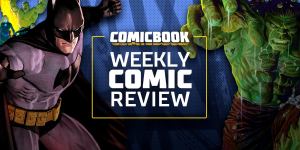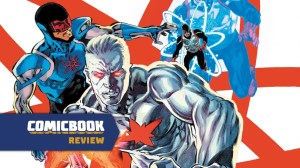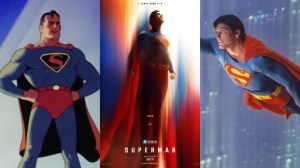Justice League is basically here. Audiences will get to see characters like Aquaman, The Flash, and Cyborg on the big screen in featuring roles for the very first time. More importantly, they’ll get to see them together and alongside already well-loved headliners like Wonder Woman and Batman — and quite probably Superman. No matter how the film turns out, its very existence is exciting for fans of superhero movies.
Videos by ComicBook.com
That also means there will likely be a lot of excitement following the film as audiences are forced to wait years for the next big team up. It’s an excellent opportunity for comics fans to share their love of the source material. That begs the question: Where to start?
We’ve assembled our top five picks (and one honorable mention) on the absolute best Justice League starting points for new readers. These are all stories that can be read on their own without requiring readers pick up extra volumes to set up or follow up on the comic they’re reading. While some are part of larger runs, they’re all excellent introductory points for a modern reader with limited knowledge of comics or superheroes. So when your friend leaves Justice League and complains that they want more, send them our way.
“Year One”

JLA: Year One #1-12
Written by Mark Waid and Brian Augustyn
Art by Barry Kitson with Michael Bair
Colors by Pat Garrahy
This maxi-series serves as both an excellent introduction to the Justice League and DC Comics. Few writers grasp the appeal and history of superheroes as well as Mark Waid, and that mastery is on full display here. There are a variety of stories that tackle odd villains and initial team-ups, providing a starting point that doesn’t feel like a greatest hits collection. The choice to emphasize the original five Justice League members and mostly leave out the likes of Batman and Wonder Woman is also valuable. It shows the strengths of the League as a concept where personalities and powers compel one another to greater feats as a team. No single member dominates the rest and the emphasis of the story is on the notion of teamwork and placing the greater good ahead of individuals.
“Rock of Ages”

JLA #10-15
Written by Grant Morrison
Art by Howard Porter with John Dell
Colors by Pat Garrahy
Whereas “Year One” approaches the Justice League as a foundational text, “Rock of Ages” provides all of the weirdness that composes many of the best stories in this team’s tradition. It includes time travel, weird science, the Fourth World, and alternate versions of many heroes. Yet the core of this story remains accessible and the oddities just make it more exciting. Like all of Morrison’s best work on JLA, “Rock of Ages” is ultimately a tale of individuals confronting incalculable evil as the League confronts a world in which Darkseid has essentially won. It’s an against all odds adventure that highlights some of the more minor members of the team and provides fascinating solutions to difficult problems. This is the highlight of the best Justice League run ever put to comics so far, and it’s a remarkably great entry point for readers wanting to see how many possibilities the DC Universe contains.
‘The New Frontier’

DC: The New Frontier #1-6
Created by Darwyn Cooke
This isn’t technically a Justice League story, but few comics embody what the Justice League is about better than Darwyn Cooke’s superhero magnum opus. This comic lays out the foundations of every significant member of the Justice League, while also highlighting the optimism of the 1960s in which they formed and the collective spirit of great superhero teams. Cooke defines characters as individuals facing incredible conflicts and anxieties in order to show the heroism of putting one’s own best interests aside to work with others. When the heroes of DC unite at the end, it’s a uniquely triumphant moment and one that leads inevitably to the foundation of the Justice League.
‘Earth 2’

JLA: Earth 2
Written by Grant Morrison
Art by Frank Quitely
Colors by Laura Martin
Morrison, accompanied by his greatest collaborator Frank Quitely, confronts the question, “what happens when the Justice League can’t solve a problem” in the OGN JLA: Earth 2. When the Justice League becomes aware of a parallel earth where an evil set of doppelgangers runs the world, they attempt to save it only to find out that the two earth’s balance of good and evil are inversely proportional. To save one means to doom the other. It’s an impossible problem, but that’s exactly the sort of issue that is most compelling to see the League face. There are no easy outs in this story and that’s what forces it to get to the heart of heroism and the idea of an optimal losing scenario.
“Tower of Babel”

JLA #43-46
Written by Mark Waid
Art by Howard Porter and Steve Scott with Drew Geraci and Mark Propst
Colors by John Kalisz
In many ways, “Tower of Babel” is the inverse of Mark Waid’s other entry on this list. It is a conclusion of sorts and focuses on how teams fall apart. That’s why it makes a lot of sense that Batman is at the core of the conflict. His tendencies for distrust and preparation lead to a terrible outcome that exposes a core flaw of the Justice League, while exploiting individual weaknesses to fascinating effect. This is the grim and gritty introduction of the lot, but is sure to please Batman fans and those that want something a bit darker.
Honorable Mention: “Starro the Conqueror”

The Brave and The Bold (vol. 1) #28
Written by Gardner Fox
Art by Mike Sekowsky with Bernard Sachs, Joe Giella, and Murphy Anderson
This is the original, and while it seems unreasonable to use it as a starting point for a new comics readers, it also seems unfair to dismiss it altogether. Fox and Sekowsky’s work in the Silver Age holds up remarkably well, and there’s plenty to enjoy in this first appearance of the Justice League. The villain is a wonderfully bizarre creation, and the combination of heroes makes it clear why Waid mostly kept this combination for “Year One”. This issue can still be genuinely recommended as an entertaining diversion and great slice of comics history to readers new and old, even if there are better starting points.




